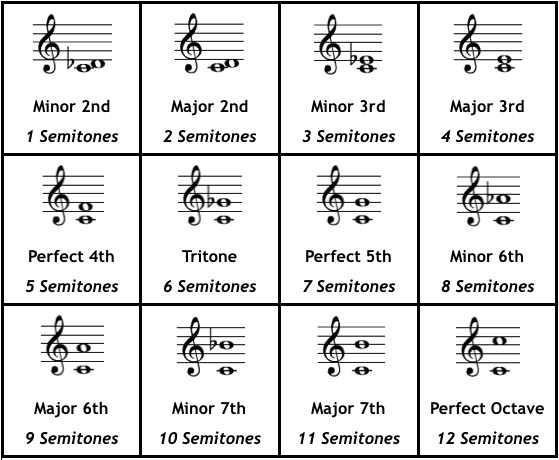Intervals
The distance between two notes is called an interval. The smallest interval in Western Music, the interval between two adjacent notes, is called a semitone or half-step. Two semitones make a tone or whole-step.
An interval can also be expressed in terms of two properties:
- a quality (perfect, major, minor, augmented, diminished); and
- a number (unison, second, third, etc.).
Perfect intervals are so-called because they are considered perfectly consonant (i.e. they sound pleasant to the ear).

Chords (Triads)
A chord is a combination of two (though usually three) or more notes played simultaneously. Chords are used as the harmonic substructure on top of which scales are played to create melodies.
Generally, in Western Music a chord is built and analysed in intervals of thirds. As we saw in the interval section above, there are two kinds of 3rd intervals:
- Major 3rd; and
- minor 3rd
Chords with three notes stacked up in thirds (degrees: 1, 3 and 5) are called Triads. Chords are referred to by their root note (AKA tonality) and their quality. Stacking Major and minor thirds in different ways creates different chord qualities. Below are all the possible qualities that triads can take, all with the root note/tonality of C.
| Quality | Degree #'s | Intervals | Notes from C | Notation | Sheet Music |
|---|---|---|---|---|---|
| Major Triad | 1 3 5 | 1 to 3 = Maj 3rd 3 to 5 = Min 3rd | C E G | C or CΔ |  |
| Minor Triad | 1 ♭3 5 | 1 to ♭3 = Min 3rd ♭3 to 5 = Maj 3rd | C E♭ G | Cm or C- |  |
| Diminished Triad | 1 ♭3 ♭5 | 1 to ♭3 = Min 3rd ♭3 to ♭5 = Min 3rd | C E♭ G♭ | Cdim or Co |  |
| Augmented Triad | 1 3 ♯5 | 1 to 3 = Maj 3rd 3 to ♯5 = Maj 3rd | C E G# | Caug or C+ |  |
By moving the bottom note of a chord to the top, you create an inversion of the chord.

A sequence of chords is called a Chord Progression.